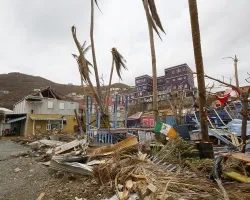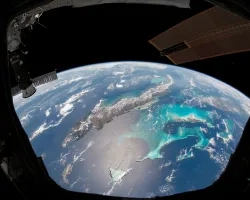“What is NASA doing here?” That was a common question from visitors at a small but popular booth tucked among the 80 exhibitors at the IAEM 69th Annual Conference & EMEX 2021 this October in Grand Rapids, Michigan. IAEM stands for the “International Association of Emergency Managers,” a non-profit educational organization representing professionals whose goals are “saving lives and protecting property and the environment during emergencies and disasters.”
Some emergency managers were surprised to learn that NASA doesn’t just look outward to the stars, but also pushes the limits of knowledge and innovation in studying Earth and atmospheric science. The Disasters team was at the conference to share resources that can inform capabilities to assess potential disaster threats, anticipate what may happen next, and help leaders and emergency officials understand and identify effective interventions. Brady Helms, a Disaster Management Coordinator for NASA’s Earth Applied Sciences Disasters program area explains further, “While NASA is not an operational response agency, we have access to scientific research, tools, and technologies that can help communities around the globe increase their resilience to disasters.” “We pride ourselves in providing access to those resources and expertise, but we also never forget that being part of ongoing conversations with decision-makers—well before hazards arrive—is critical to reducing disaster risk.”
“Events such as this give us the opportunity to share the unique resources that NASA can provide to emergency managers and decision-makers,” adds Jennifer Paris, who co-leads emergency management coordination with Helms for the Disasters program area from NASA Headquarters in Washington, DC. "But it also allows our team to hone our skills and hear lessons learned with educators and other professionals in the field of emergency management." The Disasters team connected with a wide range of officials representing local, state, federal, NGO, tribal, military, and nonprofit organizations, all of whom could benefit from the unique perspective that Earth-observing platforms enable. Paris adds, “Learning from these folks who are in the field every day helps us know where we can better fill critical knowledge gaps. The insight from NASA can help transform how communities bolster resilience, respond to perils, support relief, and sustain recovery.”
In the emergency management exhibition at the conference, known as “EMEX 2021,” the Disaster program’s Geographic Information Systems (GIS) lead, Garrett Layne, took visitors through snapshots and guided tours of the program’s Disasters Mapping Portal, one of the program's efforts to innovate new and unique methods of communicating Earth-observing data. "The portal is a powerful ArcGIS-based online interface that can give disaster managers a quick, easy and accessible way to see, analyze and download the latest near real-time products and disaster response datasets,” says Layne. “When people see first-hand that you don’t have to be an expert in GIS or data to quickly understand the maps on our portal, it’s easy for them to imagine using it in their own planning, response, recovery and mitigation efforts.”
Conference attendees were also able to meet and talk with Margaret "Maggi" Glasscoe, principal investigator for one of the Disasters program area’s A.37 portfolio of research projects. The portfolio represents the cutting edge of applied disasters research, covering a broad swath of hazard and disaster research, from oil spill monitoring, to hailstorm risk assessment, to volcanic ash and wildfire smoke plume tracking. Glasscoe’s current A.37 project focuses on integrating flood inundation data from multiple sources into the DisasterAWARE (All-hazard Warnings, Analysis, and Risk Evaluation) platform to provide a single source of global information on floods supported by a common, normalized data model. It’s the kind of project that sparks the interest of emergency managers at the conference because the work paves the way to a situational awareness tool that will specifically identify flood events and push relevant information to end-users faster.
Glasscoe emphasizes, “Establishing relationships with end-users helps us make sure our work flows from the theoretical to the practical.” “In the end, our goal is to equip decision-makers with resources that provide awareness and understanding in those moments when smart choices will make the most difference.”






